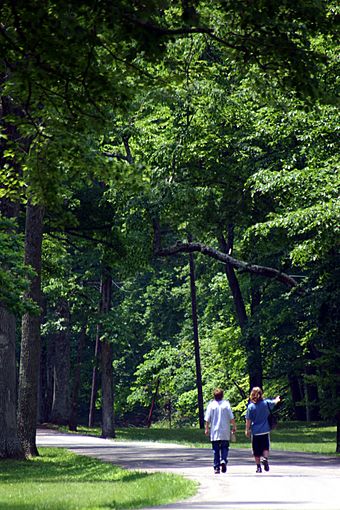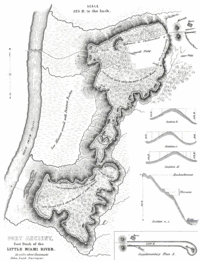Fort Ancient (Lebanon, Ohio) facts for kids
Quick facts for kids |
|
|
Fort Ancient
|
|

Nearly two miles of trails wind through Fort Ancient State Memorial's 764 acres (3.09 km2)
|
|
| Lua error in Module:Location_map at line 420: attempt to index field 'wikibase' (a nil value). | |
| Nearest city | Lebanon, Ohio |
|---|---|
| NRHP reference No. | 66000625 |
| Added to NRHP | October 15, 1966 |
Fort Ancient is a huge set of earthworks built by Native Americans. It's located in Warren County, Ohio, near the Little Miami River. This amazing site is the biggest prehistoric hilltop enclosure in the United States! It has walls that stretch for three and a half miles (about 5.6 kilometers) and cover an area of 100 acres (about 40 hectares).
The Hopewell culture built Fort Ancient. They lived in this area from about 200 BC to AD 400. The site sits on a wooded hill about 270 feet (82 meters) above the Little Miami River. Fort Ancient is so important that it's now a National Historic Landmark. The State of Ohio bought the land in 1891, making it Ohio's first state park. In 2023, it became a World Heritage Site, along with other Hopewell earthworks.
Contents
Building Fort Ancient
The Fort Ancient earthworks were not built all at once. People worked on them in at least three stages over about 400 years. Imagine how much effort that took!
The builders used simple tools. They used deer shoulder blades, split elk antlers, clam shell hoes, and digging sticks to loosen the dirt. Then, they carried the soil in baskets that could hold 35 to 40 pounds (about 16-18 kg) of earth. Archaeologists believe that the total amount of earth used in the walls would fill about 553,000 cubic yards (423,000 cubic meters).
Discovering Fort Ancient
People have known about Fort Ancient for a long time. The first map and description of the site were published in 1809. Later, in the 1840s, important researchers like Edwin Hamilton Davis and Ephraim George Squier studied the site. They called Fort Ancient "one of the most extensive" works in the entire West because of its huge size.
Many archaeologists have studied Fort Ancient over the years. Warren K. Moorehead did some of the first digs in 1887. His findings helped us understand more about this ancient place. More recently, researchers like Patricia Essenpreis and Robert Connolly have continued to learn about how the walls were built and what life was like inside the earthworks. They found evidence of different layers of building and even places where people lived.
What Was Fort Ancient For?
For a long time, some archaeologists thought Fort Ancient was a giant fort built to protect against enemies. But now, most experts don't think that's true. There are a few reasons why:
- The ditches are inside the walls, not outside. If it were a fort, the ditches would be on the outside to stop attackers.
- The walls have 84 openings, like gateways. It would be very hard to defend so many openings if enemies attacked.
- Archaeologists haven't found enough evidence of a large population that would be needed to defend such a big fort.
Today, most archaeologists believe the walls were used for social, economic, political, and ceremonial reasons. They think the site was a special place for gatherings and important events. Researchers have even found that the way the site was built lines up with important events in the sky, like the movements of the sun and moon. This suggests it was also used for observing the sky and perhaps for special ceremonies related to the seasons.
Visiting the Museum
Today, Fort Ancient is a state historical park that you can visit! It has a large museum that covers 9,000 square feet (about 836 square meters). The museum teaches visitors about 1,500 years of American Indian history in the Ohio Valley.
You can learn about the earliest people in North America, how farming developed, and what happened when Europeans came to the area. The museum also has a classroom, a research area, and a gift shop. It's a great place to learn more about the amazing history of this region.
The Old Village
In the 1800s and early 1900s, a small village existed right at the base of the Fort Ancient Earthworks, along the Little Miami River. This village once had a post office, a hotel, a blacksmith shop, and other businesses and homes.
The village isn't there anymore, but the area is still active. Today, you can find a canoe livery (where you can rent canoes) and a private campground. The Little Miami Bike Trail also runs through the area. This trail follows the path of an old railway that used to be here. It's a great spot for outdoor activities and to imagine what life was like long ago.
Images for kids



